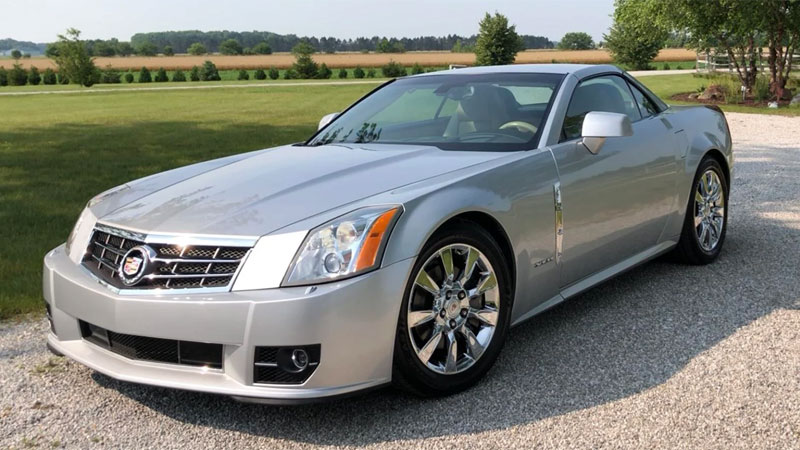Declining Cadillac sales in the 1990s forced General Motors to take a hard look at its luxury division and that marque’s model offerings. New models were soon conceived including an Evoq concept, a two-door roadster that made its debut at a 1999 Detroit auto show.
Five years later the Cadillac XLR was introduced, a model underpinned by the same platform used by the Chevrolet Corvette.
From Concept to Reality
The 1999 North American International Auto Show in Detroit featured the Cadillac Evoq, a concept vehicle created by a design team headed by Wayne Cherry, Vice President of General Motors Design. Cherry oversaw the design of several other noteworthy vehicles including the Chevrolet SSR, Pontiac Solstice, and the Cadillac Sixteen concept.
The Evoq concept was based on the fifth-generation Corvette platform, a rear-wheel-drive roadster with a retractable hardtop roof. The Evoq featured Cadillac’s Northstar V-8 engine and was paired with a four-speed automatic transmission.
Auto show attendee reaction to the Cadillac Evoq was highly favorable with GM soon committing to build the new model. However, the eventual production vehicle was not released until 2004 when the sixth-generation Chevrolet Corvette was also introduced.
Like the Corvette, the Cadillac XLR was built at the Corvette manufacturing plant in Bowling Green, Kentucky.
Cadillac XLR Essentials
General Motors outfitted the Cadillac XLR with a 4.6-liter V-8 engine. Its Northstar engine was found in other Cadillac models of that era and differed from the 6.2-liter V-8 that powered the Corvette.
The XLR engine was rated at 320 horsepower and 310 foot-pounds of torque, and was teamed with a five-speed automatic transmission. Beginning in 2007, a six-speed automatic transmission was made standard.
The XLR and Corvette shared the same hydroformed frame-rail architecture, with the XLR utilizing components from both the C5 and C6 Corvette.
Like the Corvette, the Cadillac XLR featured aggressive styling with a long hood and a chiseled body, with 18-inch wheels and outfitted with clustered quad exhaust pipes. Its base price was approximately $20,000 above the Corvette, starting out near $77,000.
Standard equipment with the Cadillac XLR included keyless entry, a tilt and telescoping steering column, a heated steering wheel, steering wheel mounted controls, power accessories including a power trunk lid, eight-way power seats, and dual climate control.
Leather trim was used throughout the cabin on seating surfaces, across the dashboard, on the doors, and around the steering wheel. Alloy and wood trim accents were standard.
Cadillac XLR-V
Beginning in 2006, Cadillac introduced a V-Series model to the XLR line. The V-Series is a line of high-performance models that were also found in special versions of the CTS and STS sedans. The XLR-V was priced from just under $100,000.
The Cadillac XLR-V was powered by a 4.4-liter supercharged V-8 engine making 443 horsepower and 413 foot-pounds of torque. It was teamed with a six-speed automatic transmission that could also be shifted manually.
This model featured magnetic ride control and an enhanced suspension system. Key amenities included temperature-adjusted seats with heating and cooling features, Zingana wood trim, and aluminum accents.
End of the Road
After a six-year model run, GM announced in 2009 that the Cadillac XLR would be discontinued. GM had also stopped making the 4.4-liter V-8 engine for the V-Series, “due to market conditions.”
The timing of the XLR’s demise coincided with GM’s bankruptcy and restructuring, a move that enabled the automaker to quit making low volume and unprofitable vehicles across its multiple brand lines.
Approximately 15,400 XLRs were sold for its entire model run. The vehicle was considered less refined than competing European models including the Mercedes-Benz SL500 and the Jaguar XKR. Its cramped interior, uninspiring steering feedback, and large gaps between some interior panels were among the deficiencies cited by industry analysts.
Cadillac’s flagship roadster is no more, but its high-end performance lives on in other vehicles. The V-Series continues in the CTS, a line of vehicles powered by Corvette’s supercharged 6.2-liter V-8 engine.
See Also – Book Review — The Allure of the Automobile
Photo copyright General Motors Company.
- 2024 Mazda CX-50: A Compact SUV with Premium Aspirations - Apr 15, 2024
- 2024 Ford Mustang (Iconic Pony Car Evolves) - Apr 4, 2024
- 2024 Ford Maverick (Looks Like a Truck, Drives Like a Car) - Mar 28, 2024


